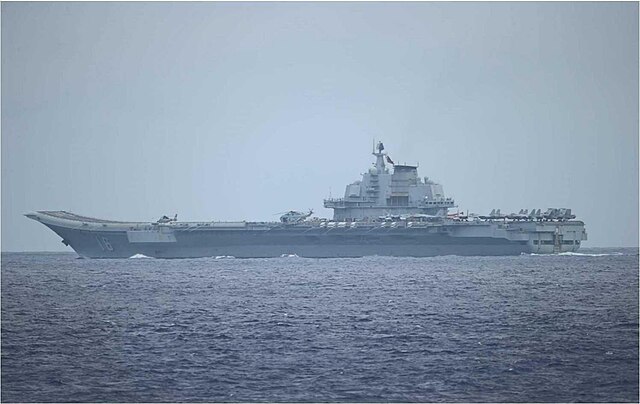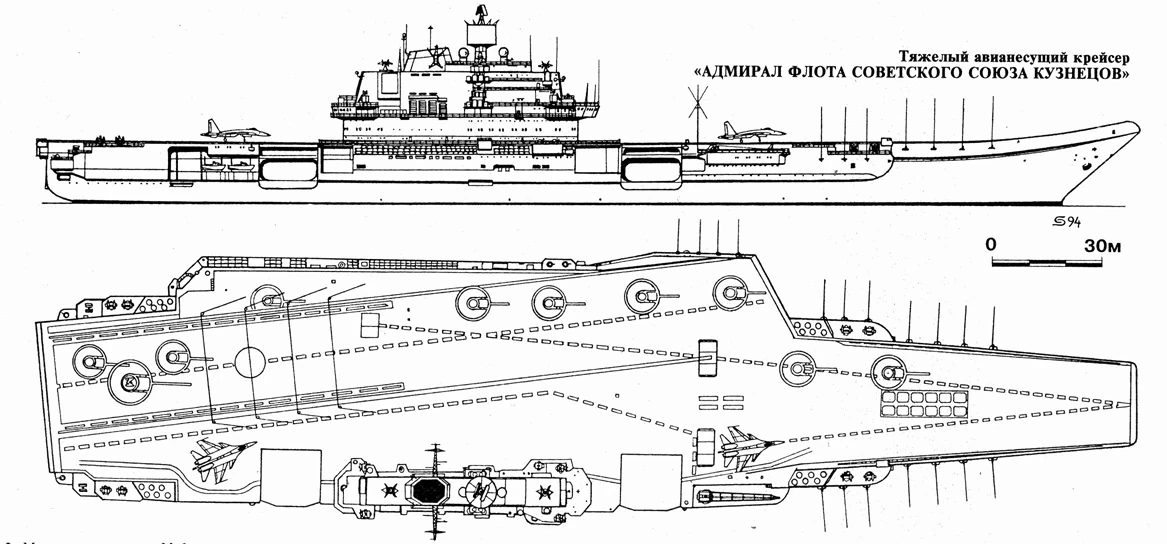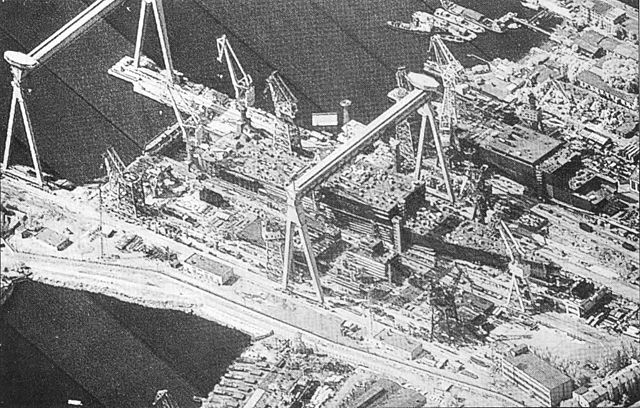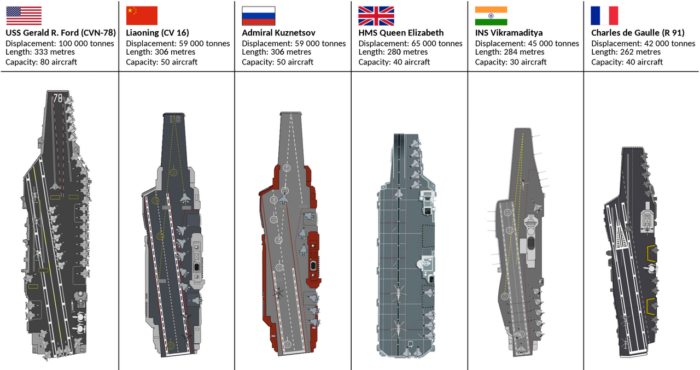
CNS Liaoning (16) is the sole Chinese Type 001 aircraft carrier and first aircraft carrier commissioned into the People’s Liberation Army Navy Surface Force, now considered a training ship and officially designed to familiarize the PLAN aircraft carrier operations. Her career is currently of twelve year now (2024) expected to be extended beyond 2030-2034 and after upgrades performed by late 2018, she was announced ready for a combat role from 2019, which she demonstrated since. As her operational status beyond 2035 is very much dependent of the state of her powerplant and hull, an inheritance of late 1970s Soviet tech. Indeed, she was originally laid down in 1985 as the Kuznetsov-class aircraft carrier “Riga”, launched on 4 December 1988, and renamed Varyag in 1990. After the dissolution of USSR in 1991, construction was halted when 68% complete and she was sold to Ukraine, which lacked the founds to complete her so she was sold to a Chinese Buyer officially to be converted as a hotel-casino in Macau. The latter was as intermediary for the Chinese Government.
Stripped, she was towed through the Dardanelles and eventually ended at the Dalian naval shipyard in 2002, rebuilt and commissioned as Liaoning on 25 September 2012, but only officially “combat ready” by November 2016. Western intel had serious doubt on how well she will perform in case of a major conflict. Her story is quite a peculiar one and she is now an important stepping stone in the will of Pekin to align four task forces in the Pacific. Type 002 Shandong (an improved STOBAR) is now commissioned since 2019, type 003 Fujian (First CATOBAR) was launched on 17 June 2022 and is expecting commission in late 2024. Type 004 (unnamed) is no yet laid down but expected to be the first of the Chinese first CATOBAR carrier class with four on order for 2028-2035, the first probably replacing the Liaoning. Expect updates in the near future.

Origin: Project 1143.5 design
Speaking of “development” for such a vessel is quirky, since she was entirely developed and designed in USSR. Her story is the story of Project 1143.5. It’s genesis went back to the late 1960s as Project 1145 was first envisioned (later to be completed as the Kiev class). In October 1978 additional Project 1143 cruiser-carriers were approved, the fifth being designed with catapults and arresting gear as Project 1143.5. Nevskoye Bureau plan was approved at the end of 1979 for full load displacement of 65,000 tons and CATOBAR capability. It was reversed in 1980 by Soviet defense minister Dmitry Ustinov, downgrading the class to a STOBAR, 10,000 tons ship still with VSTOL aircraft. Project “Nitka” was revised again with a 12-degree ski-jump, later known to the West as the Kuznetsov-class, first Soviet carrier with a full-length flight deck unlike the Kievs which were hybrids. In addition, its cruiser armament was mostly made of under flight deck and sponsons VLS, including 12 anti-ship cruise missiles.
For memory STOBAR means “Short Take-Off But Arrested Recovery”. The 12-degree ski-jump at the bow spare the use of a catapult, provided the aircraft took off at full thrust from a fixed position, and was not heavily loaded. The Kuznetsocv class still possessed an angled recovery deck with arresting wires so not to interfere with launching aircraft, and full flight deck area of 14,700 square metres (158,000 sq ft) to play with, plus two aircraft elevators and on paper, 33 fixed-wing aircraft and 12 helicopters, Su-33 fighters and Ka-27 naval utility helicopters.
Originally their armament comprised twelve P-700 Granit (SS-N-19 Shipwreck) SSM cruise missiles common to the Kirov-class battlecruisers in the front deck VLS before the inclined ski-jump, and so compromised any launch while firing. SAMs comprised 24 vertical Tor missile system (SA-N-9 Gauntlet, 192 missiles) in sponsons, eight Kashtan CIWS mounts, combining 9M311 SAMs and twin GSh-30 30 mm rotary cannons plus six AK-630 30 mm CIWS and even ASW close defense with an UDAV-1 ASW rocket launcher.
The saga of Varyag/Riga/Liaoning
As a Soviet Ship
Varyag started as a Soviet ship, then Russian post-1991, then Ukrainian until 1998, then Chinese (civilian) registered in the duty-free area of Macau until 2002, and then in the Chinese PLAN, commissioned in 2012. The whole process, from laying down the keel to commission and even operational status in 2019, had been of 27 years. Not considering the way events unfolded, this was the longest “construction” time of any ship anywhere, anytime, ever. Many ship’s career lasted way less than that. As for the utility of acquiring such a rusty hulk, nor purchasing two former Kiev class carriers, it must be linked with the closely related Kiev class, the namesake purchased for a theme park in Tianjin since 2004 and Minsk sold as a museum in Jiangsu since 2016, burnt 16 August 2024.
The first ship in class of Project 1145.5 was laid down at Black sea shipyard 444, Mykolaiv South now in Ukraine, in April 1982 under the name of Tbilisi, then renamed Leonid Brezhnev after the death of the latter, then Riga in 1991, and Admiral Flota Sovetskogo Soyuza Kuznetsov as completed in 1990. Her sister was laid down at the same yard on 6 December 1985, the same day her sister was launched, since N°444 yard needed to be cleared out. She was named Riga originally and then Varyag (after the name of the Viking guard of Byzantine emperors) post-1991 when her sister became Kuznetsov. She was launched on 4 December 1988 and her own design was altered as many years separated her from her sister by Nevskoye Planning and Design Bureau.

She was berthed, waiting completion at the yard, when events precipitated. As the Soviet Union collapsed in 1991, she was only 68% complete and construction was halted. It was soon clear that the new Russian federation had no budget to complete here, and she was put up for sale, not by Russia but by Ukraine as the incomplete ship was not commissioned, so the hull belongs to the yard, and by definition belongs to the new independent state of Ukraine. The latter had a still sizeable navy, which was clipped down by treaty and forced by budgetary constraints.
Ukraine approached China, India, and Russia. Russia declined, as India, at the time looking to built its own carrier and in between purchased Hermes.
China as a potential buyer (1992-98)
China sent a delegation in 1992 and reported her hull in “good condition”, recommended a purchase, but the Chinese government declined the purchase due to the international diplomatic situation and post-Tiananmen consensus and gorverment events at home like. Ukraine left the ship without maintenance under the elements so the hull degraded year after year. This fact was communicated to the Chinese which were well aware of it and probably devised a plan to acquire the ship in other ways. It’s only in 1998, that the hulk was sold at auction for $20 million, to “Agencia Turistica E Diversões Chong Lot Limitada” from Macau. At the time, “Vice city” and former Portuguese cold war colony seems a good cover to pretend she would be converted as a floating hotel and casino.
Chong Lot, the buyer and millionaire, proposed to tow her and launch a conversion for $200 million ten times the purchase amount.
Western observers soon reliaed Chong Lot had no listed telephone number nor was present at his listed address which bureau was instead staffed by former officers in the Chinese Navy. The affair bounced when Officials in Macau denied Chong Lot’s application for a casino while analysts underline the deterioration of the hull was neitehr suitable for an operational warship and even unsafe as a floating casino, unless she was drydocked and overhauled, probably at a greater cost. Many argued that the “casino” case stayed a real possibility since the PLAN at the time seemed to concentrate on high-end submarines, notably SSBNs. Later as said above, Kiev and Minsk were purchased as “tourist attractions”. They became so.
All this time, the ship was still in Ukraine.
The transfer (2001)

The passage from Ukraine to China was a saga of itself: In June 2000, Varyag was towed for the first leg of her trip to Macau by a tugboat to the Bosphorus. But as she approached, the Turkish navy sent a warship and a pilot came aboard with an official delegation. Turkey (a member of NATO) denied permission to pass through. The alleged reason was that she was at risk to be turned across by a gust of wind and block the entire strait. This was true in some way, but experts knew that the buyer just would have to order more tugboats to solve the problem. But Chong Lot was in troubles, to say the least. Macau authorities denied the conversion of the ship as a casino as intended. The Montreux convention which applied to the Bosphorus and denied the transfer or any aircraft carrier of more than 10,000 tonnes was already solved by the classification of these ships as “heavy cruisers” and even though, the hull was completely disarmed and lacked her radars.
In 2015, Xu Zengping (a Hong Kong Businessman and former military basketball player) told the South China Morning Post her was originally cast to purchase the vessel on the PLAN’s behalf. The floating hotel and casino was his cover story. He then visited the ship and decided to purchase her on his private funds creating for $6 million Chong Lot under the Macau shell corp. He also arranged the passage of 40 tonnes of blueprints to China overland, in eight trucks and used bribery to obtain the ship from Kiev. It alleged he was never reimbursed and spent 18 years paying his debts whereas Ji Shengde who initiated the mission was jailed for “smuggling”.
Back in 2001 and Varyag was stuck for the next 16 months being towed around the Black Sea at a cost of $8,500 a day while bills were no longer paid. The tugboat operator seemingly offered paid trips to pay for his own bills. Chinese officials fro there started negotiating with Turkey and offered concessions. At last by August 2001, she was allowed to pass and on 1 November 2001, she went to the cleared Bosphoris of all other traffic, this transit was completed without incident on 2 November. Two days laterr however as she entered the Ionian sea, she was struck by a force 10 gale and broke adrift off Skyros. A tugboat managed to have her back under tow on 6 November but a sailor died while attempting to attach tow lines. Next, the second step was to have her crossed the Suez Canal, as there was a serious danger to see her transiting all the way around Africa and passing through the windy, stormy Cape.

But there was a hitch: The Suez Canal does not permit passage of unpowered ships and maintained that position after negociations. So the second option, dreadful, was left. Crossing the Strait of Gibraltar, the ship transited through the Pointe des Almadies and Cape of Good Hope, again with a cooperative weather and vigilant tugboats fleet’s crews. She manage to reach Cape Agulhas and enter the Indian Ocean, then corssed the Straits of Malacca at 6 knots after a 15,200-nautical-mile (28,200 km; 17,500 mi) trip. En route supplied were brought in to sustain the tugboats in Piraeus, Las Palmas, Maputo, and Singapore. Varyag arrived at last on 20 February 2002, not in Macau, but was anchorted in safe waters. By that time her distantion was clear to all. On 3 March she entered the Dalian naval shipyard, northeast China. The one and only yard capable of handling her overhaul and reconstruction for the PLAN. Total cost at that stage between the purchase and transit cost was around $35 million. But the PLAN still had a rusty hulk on thetr hands at that stage.
Overhaul, and design of the Type 001

Liaoning at CSIC shipyard in Dalian, China (2012)
If the hull was in sad state, with coastings and pain gone, and some portion of the hull so badly rusted that the bare metal had been exposed and thinned down in many places. The hull underwater however had been colonized by Black sea marine life which crust somewhat preserved her integrity. Her machinery was in good state however, they remained intact, well covered at the time of purchase, preserved in grease seals. So the ship needed for a start a solid drydock work first to clean the hull, inspect its integrity in and out, then scrap remaining pain, probably sandblast most of her structure for a full re-coating, re-painting all around. Then, she arrived basically as an empty hull, heavily ballasted to stay stable. Both the ballast needed to be extracted, and plans made to install all the elecvtronics suite and properly complete her on Chinese specifications, which were left to setup. On this chapter it’s probable that detailed plans obtained since 2001 until she arrived in 2002 left some time to plan her reconstruction.


701st Institute under Zhu Yingfu and Wu Xiaoguang were tasked to redesign Varyag. Wang Zhiguo became general system engineer, Yang Lei general supervisor of the programme, probably nalmed “Type 001” by that point. It was later estimated that the whole process of redesigning the ship, building all sub-systems, electronics and aviation park was equivalent when she was commissioned ten years later to about ten new destroyers in total cost. Varyag stayed with only preservation work done in Dalian waters and only entered her assigned drydock (which did not existed at the time) by June 2005. Residents could see her island painted in a red marine primer and the rest of the hull was sandblasted and painted as well, at least saving her for more ravages as the design was completed and sub-systems designed as well. Satellite imagery soon revealed she had the Type 348 active electronically scanned array (AESA) radar and Sea Eagle radar installed and later it was confirm that her air defence system comprised Type 1130 CIWS and HQ-10 SAM missile system in sponsons. The former deck silos for the Granit were removed, the deck plated over, freeing hangar space.
On 8 June 2011, General Chen Bingde made a public declaration acknowleging her refit and on 27 July the MOD precised she was to be used for “scientific research, experiment and training”.
Hull and general design
Type 001 kept the original specifications intact, so apart displacement which changed due to many altered details in electronics and armament, she kept the same size. She displaced as completed 43,000 tons, light, 54,500 tons, normal and 60,900 tons, full load displacement for an overall lenght of 306.4 m (1,005 ft 3 in) and 270 m (885 ft 10 in) at the waterline. Her waterline beam was 35 m (114 ft 10 in) and her flight deck overall width was 74.4 m (244 ft 1 in). Her max draught was probably around 11 m (36 ft 1 in). To compare, she was a meter and a half longer than Kuznetsov, and two meter and a half wider at the flight deck.
Powerplant
Her powerplant was “stock” ex-Soviet 1980s technology. Her four Steam turbines TV12 were fed by eight KVG-4 boilers instead of gas turbines, an oddity at the time, 80,000 hp each for a grand total of 200,000 hp (150 MW) on the four fixed pitch propellers. It was composed of:
-Four 50,000 hp (37 MW) turbine
-Nine 2,011 hp (1,500 kW) turbogenerators
-Six 2,011 hp (1,500 kW) diesel generators. The latter provided all systems when boilers were shut cold.
Top speed is officially still of 32 knots (59 km/h; 37 mph)for an official range of 3,850 nmi (7,130 km; 4,430 mi) at this top speed. In reality like the original Kuznetsov she would be capable of 8,500 nmi (15,700 km; 9,800 mi) at 18 knots (33 km/h; 21 mph). The endurance based on food and water reserves is 45 days, given the ship has a crew of 1,960 plus an air group crew of 626 and 40 flag staff.
Armament
The greatest changes were in that area. The PLAN had no limitations in terms of sea access and no need to brand these ships as “cruisers”, not to arm them as such. They were classed as aircraft carriers and looked rather at US practices than Soviet ones in that matter. Nevertheless, the generous original spaces were exploited and the Type 001 still featured a close-in armament compsed of CIWS guns and short SAMs. This made these ship lighter, and it as counted on the anti-ship of boh the escort and multitole J-15 and Changhe Z-18 to deal with ships at long range or intercept incoming air threats. see.
HQ-10 Flying Leopard

The 24-tubes version on display
Designed entirely in China this HQ-10 has similar role to the USN Rolling Airframe Missile (RAM) as point defense missile systems, ideal for the sponsons.
These are subsonic missiles with a has a range of 9 km/6 km against sub/supersonic targets. It was also reputed capabkle of intercepting missiles, including sea-skimming ones at 1.5m over the sea surface. Guidance system is provided by the matrix imaging infrared (IIR) seeker of each missiles with analysts almost sure these combines passive radar seekers or semi-active radar seekers.
The launcher is customisable with 8, 15, 18 and 24 tubes canisters in order to be deployed on ships from Corvettes to the Liaoning. Interval between launches is reputed to be 10 seconds.
On Liaoning, these are located on both forward sponson and one on the aft port sponson, all of the 18 tubes model, FL-3000N type so 54 missiles in all. Some sources earlier alleged four launchers only for 72 missiles. It’s possible that in wartime, both an extra HQ-10 and CIWS could be added given the available sponson space.
⚙ specifications HQ-10 |
|
| Weight | 20 kg |
| Dimensions | 2 m x 127 mm |
| Propulsion | solid fuel |
| Speed | Subsonic |
| Range | 0.5 km to 9 km |
| Guidance | Imaging infrared (IIR) |
| Ceiling | 1.5 m to 6 km |
| Payload | 3 kg HE FRAG, infrared proximity fuse |
Type 1130 CIWS

This system was designed by the 713th research institute as Project 850, powered by two electric motors and coupled with the radar TR47C J-band radar (NATO Rice Lamp) developed at the Xi’an Research Institute of Navigation Technology and completed by the Optical Fire Control)3/H/ZGJ-4 system from the Central China Optronic Research Institute. It was deployed from 2003 as standard CIWS of the PLAN. It is automated, but with human remote operator supervision. Its roots could be traced back partly to the French 1987 Sagem Samos prototype. It existed in a type 730 7-barrel variant as well. On Liaoning these are 12-barrel variantsn Gatling style, fed by two ammunition boxes, each holding 1280 rounds (total 2560 rounds) each. They are located on the two sponsons aft, and one on the starboard sponson.
⚙ Type 1130 CIWS specifications |
|
| Weight | Unknown, c15 tonnes |
| Barrel length | 1×30 mm H/PJ-12 11-barrel 80 cal. |
| Elevation/Traverse | -25° +85° and c180° |
| Loading system | Gravity feed, two belts |
| Muzzle velocity | 1,000–1,150 m/s (3,300–3,800 ft/s) |
| Range | 3–4 km (1.9–2.5 mi), 5 km max |
| Guidance | TR47C radar+ OFC-3 optonic FCS |
| Crew | Remote |
| Round | 30×165mm AO-18 HEI-Frag, Frag-T, APFSDS |
| Rate of Fire | 10,000 rounds/minute |
Alleged ASW Rocket Launchers
Two such systems were allegedly located on the both sides’s aft sponsons, in superfiring position to the CIWS, however it seems they are not formally “registered”. Older sources speaks of 12 tubes of the RBU-6000 types but it never was in Chinese service. More likely the Type 87, which is a 6-tubes system. On navypedia they are cited as “RBU-12000 ASWRL”. They are six tubes, so same type as the Type 87. Today these are being proven to be instead Chaff launchers (see protection).
Note also that the original cruise missile launchers were never installed, their base removed during the refit and the hangar bay enlarged instead.
Sensors
Type 346 radar S-band AESA: Developed by the Nanjing Research Institute of Electronics Technology and using the 30N6EI Tombstone phased-array Flap Lid antennae (from Russia) and from 2004 C band active phased-array radar. 400m range ans also used by the Type 052C, D and 055 destroyer in successive variants. Like the Aegis is enabled to track around 200 targets at once.
Type 382 Radar 3-D search: Uses two back-to-back planar arrays on a rotating mount, derived from the Russian Fregat MAE-3 radar (NATO Top Plate) but possibly reverse engineered.
Type 347G radars: Three fire control radar associated with the HQ-10 systems.
Type 756 radars: Two, associated with the CIWS, their optronic system taking over at closer ranges.
Protection
Passive: Underwater protection made of three longitudinal bulkheads with the second armoured. Aviation fuel tanks and magazines have box protection.
Active: ECM suite, four 24-tubes and two 16-tubes decoy Rocket Launchers. The located of the first four is on the forward sponsons and island, the last on the two aft sponsons, for some time identified as ASWRLs.
Facilities

The aircraft facilities comprises a flight deck that was measuring 304.5 by 71 meters and a total of 14,800 m² in surface. The hangar measured 153 m long for 26 m wide and 8 m tall for a surface of 3,978 m² and a volume of 31,824 m. The two deck-edge elevators measures 20 x 15m and presents a capacity of 40t. The ski-jump instead of catapults made take-offs from a fixed position, at full throttle behind a lifting fire wall.
There are three such positions on deck:
Two forward, close to the forward starboard elevator, one port and one starboard, with two ordnance lifts in between. The distance for takeoff is about 120m long. The ski jump is merely helping to sustain a minimal altitude before the engine full power could lift the aircraft properly. As said above, the limitation is that aicraft could not take off at full load, a severe handicap compared to CATOBAR, notably for strike missions. The third take off spot is located way further aft, aligned on the port TO run and about 110m long. Combined with the forward run, this goes for 230-250m long, enough for a more heavily laden aircraft, so to compensate the shortcoming explained just before. But its location prevents a simultaneous landing.
By the way, the landing track is about 200m long, with four main hydaulic arresting cables located 50m from the poop. The parking space is delimited by a white line and the deck is not thrust-proofed like the rest of the flight deck, as it’s the permanent parking around the island starboard, usually seen with 5-6 jets, 2-3 helicopters.
Aircraft fuel stowage is about 2500 t of jet fuel. About helicopters, the ship also received four landing spots, one aft of the landing deck, two forward of it, one in between forward runs.
The landing system deported to port amidships used is probably roughly similar to the Kuznetsov’s.
Air Group
This topic was the subject of many publications and debates, but the typology on board was fairly standard as for Jets went. In 2014 the air grooup was observed to be composed of twenty four J-15 jets, four Z-18F, four Z-18J, two Z-9C, and two Ka-31 for a nominal capacity of 48 aircraft, more than the Kuznetsov. Today the complement is rather 40 total decomposed between 24 Shenyang J-15, six Changhe Z-18F, six Changhe Z-18J and two Harbin Z-9, no Ka-31. The latter was the Chinese Variant of the “Helix” ASW helicopter but was rarely seen. Instead, twelve heavy duty Z18 are used for a variety of roles and the two Z-9 are used as plane guard.
J-15 Flying Shark

J-15 fighters on Liaoning, basically Chinese copies of the SU-33.
Given the fact the Chinese carrier was based on the Kuznetsov’s, the latter was geared to operate the SU-33 Flanker-D. The latter was a naval variant initially known as the SU-24K of the Flanker, manufactured for the Kuznetsov around 1987 and up to 1999 with c24 total. The J-15 Flying Shark (Flanker-X2) developed by the Shenyang Aircraft Corporation (SAC) and the 601 Institute after the unfinished prototype T-10K-3 Su-33 was acquired by SAC from Ukraine in 2001. The J-15 entered service in 2009 and presents very smimilar caracteristics. Since it was prepped as the primary multirole jet on board Type 001, 002 and 003, some 60 had been estimated built so far.

In short, the J15 measures 22.28 m (73 ft 1 in) by 15 m (49 ft 3 in) winspan and 7.4 m (24 ft 3 in) wings folded, 5.92 m (19 ft 5 in) high. Weight empty is 17,500 kg (38,581 lb), up to 32,500 kg (71,650 lb) max TO with 9,500 kg internal fuel capacity (see range), powered with two Saturn AL-31 afterburning turbofans developing 122.6 kN (27,600 lbf) with afterburner initially (ratio 0.93) or two WS-10B afterburning turbofans for 132.2 kN (29,700 lbf) thrust dry and 135 kN (30,000 lbf) with afterburner, thrust/weight ratio of 1.01-1.07.
This produced a top speed of Mach 2.4, ferry range of 3,500 km (2,200 mi, 1,900 nmi), ceiling of 20,000 m (66,000 ft).
This compared well with the F-18 Hornet, which is quite smaller.
Armament comprised a fixed 30 mm GSh-30-1 cannon with 150 rounds and a payload of 6,500 kg, including the PL-15 long-range, PL-12 medium-range, PL-10 and PL-8 short-range air-to-air missile.
But also the YJ-83K and YJ-12 anti-ship missile, the KD-88 standoff land attack missile, YJ-91 anti-radiation missile, all compatible bombs and rockets as well as a UPAZ-1A buddy refueling pod.
To put things in perpective, here are some perks about these ordnances:
-The PL-15 (NATO CH-AA-10 Abaddon) is capable of March 4+ and 300 km range, extending the bubble well over 500 km around the carrier given the patrol circle of the J-15.
-The YJ-83K is the equivalent of the Exocet MM40 (230 km for the YJ-83KH, mach 0.9 to 1.4 terminal)
-The YJ-12 is a ramjet model for Mach 4, up to 500 km range. Suspected to have an optional nuclear tactical warheard.
Changhe Z-18

The reversed-engineered French SA-321 super frelon, made by Avicopter (Changhe Aircraft Industries Corporation) and in service from 2018, long after the Super Frelon was removed from service in France. This heavy duty, three WZ-6C turboshafts engine sea-landing capable multirole helicopter could be used for a wide variety of tasks.
The Crew is composed of 2 pilots, with a capacity of 27-30 troops, small vehicles, 5 tonnes cargo for a fully loaded range of 1000 km. This is could be used as supply airbone cargo.
Not small, the Z18 measures 23.05 m (75 ft 7 in) overall with 19 m (62 ft 4 in) rotor span, 7 m (23 ft) high, for 7 tons (15,432 lb) light, 13,8 tons (30,360 lb) max,
Top speed is 336 km/h (209 mph, 181 kn) for a 9,000 m (29,528 ft) ceiling.
It could carry up to four YJ-9 anti-ship missiles in an ASS role.
The Z-18F are used as primary ASW helocopters, with chin-mounted surface search radar, dipping sonar, four lightweight torpedoes, 32 sonobuoys.
The Z-18J are used as Airborne early warning (AEW) variant with a lowerable radar antenna in place of the ramp. This is an original solution to replace the absence of an equivalent of the Hawkeye early airborne warning aircraft.
Harbin Z-9

They are used as SAR (search and rescue), liaison, and plkane guard models. Licenced French Eurocopter AS365 Dauphin, with 200 built entering service in 1994. Two on board, one always in flight during take offs, the other in maintenance or available for other tasks.
Crew 1-2 pilots, 10 passengers/1,900 kg (4,189 lb) payload internal and up to 1,600 kg (3,527 lb) slung. 12.11 m (39 ft 9 in) for 4.01 m (13 ft 2 in) in height, 2,050 kg (4,519 lb) empty and 4,100 kg (9,039 lb) max powered by two Zhuzhou Aeroengine Factory WZ-8A turboshaft rated for 632 kW (848 hp) each, 305 km/h (190 mph, 165 kn) max, ferry range 1,000 km (620 mi, 540 nmi) or 5 hours autonomy, max 4,500 m (14,800 ft). Unarmed, albeit it could still carry two ET52 ASW homing torpedoes, or anti-tank and anti-air missiles if adapted.

Profile and deck view from navypedia (src below)
Large illustration on deviantart
⚙ specifications |
|
| Displacement | 54,500 tons normal, 60,900 tons, full load |
| Dimensions | 306.4 x 74.4 x 35m (1,005 ft 3 in x 244 ft 1 in x 114 ft 10 in) |
| Propulsion | 4x Steam TV12 turbines, 8 KVG-4 boilers 200,000 hp (150 MW) |
| Speed | 32 knots (59 km/h; 37 mph) |
| Range | 3,850 nmi (7,130 km; 4,430 mi) max speed, 8500 nm/18 kts |
| Armament | 3× Type 1130 CIWS, 3× HQ-10 (18 each) |
| Protection | ASW bulkheads, avgas/ammo boxes, ECM, Chaff RL, see notes |
| Sensors | Type 346 radar S-band AESA, Type 382 Radar 3-D search, see notes |
| Air Group | 40-48 aircraft, see notes |
| Crew | 1,960 crew+ 626 air group+ 40 flag staff, c2500 total |
Career of the Liaoning

Sea trials commenced from 10 August 2011, until 15 August 2011. So it is estimated she was “completed” enough in january-february 2011, perhaps with Dalian flooded dock trials and berthed trials after re-launch.
On 29 November 2011 she left port for her second set of trials after initial corrections at Dalian. She completed her eighth sea trial between 7 and 21 June 2012, back to Dalian for more fixes. In July 2012, she made her “shakedown cruise” like trials over 25 days. Trials were declared completed by early August 2012. She moved to the arsenal part of Dalian to be loaded with brand new Shenyang J-15 aircraft as well as their complement of KJ-88, YJ-83K and YJ-91 missiles for airborne weapons systems trials.
Sea trials reported once a steam burst in their engine compartment. It seems she only had injured sailors and all managed to evacuate the co,ncerned section, but she lost power. It was ultimately restored, but the event, albeit made public is not detailed.
On 23 September 2012, she was at last officially handed over to the PLAN, formally commissioned on 25 September 2012 in presence of many top party officials, and named Liaoning, the province where she was completed.
On 26 December 2012, the People’s Daily reported a 4-5 years of qualifications and tests until full capacity as operational ship, so officially she was listed as a training ship until 2018 and so not assigned to any fleet or sent to any deployment. She stayed all along close to Dalian but cruised the coast north or south at several occasions.
On 4 November 2012, the PLAN’s official website reported her first touch-and-go by a Shenyang J-15s had performed carrier touch-and-go training.
On 25 November 2012, J-15s were announced making five successful arrested landings.
In June 2013, she started more advanced flight tests with personnel from the fleet air arm of the Brazilian Navy providing training support, albeit their models differed greatly from the J-15.
In August 2014, two pilots were allegely killed while testing jets from Liaoning according to W medias. Officials denied these favilities as unrelated wit the carrier. The source Xinhua, lacked precisions.
The Shanghai Morning Post the same month specified her air group as a training carrier, to be 36 aircraft total, with 24 Shenyang J-15 fighters (this remains constant) as well as six Changhe Z-18F anti-submarine warfare (ASW) helicopters, four Z-18J airborne early warning helicopters, two Harbin Z-9C rescue helicopters. It is roughly similar to the approach taken for the Kuznetsov, using ASW helicopters to support its nuclear submarines, notably its precious SSBNs until their “dilution” or for the escort of large surface combatants and task force. It was also capable to provide its long range air defence, or to operate with land-based strike bombers on long range missions, providing on-side escort. Like interventions deep in the south China sea and beyond.

Geopolitical analysts since had tried to define the role of this carrier as part of the Chinese PLAN strategy. It was argued especially in the latter years from 2018 that Liaoning was to be used to intimidate other countries having territorial claims in the South China Sea and extending air control over these seas, especially today as tension rise with the Philippines and other countries.
In December 2016 as one of her first deployments, she cruised the Western Pacific, passed through the Miyako Strait between Miyako-jima and Okinawa, which was controversial, shadowed all along by the JSDMF. On 18 April 2018 she took part of live-fire exercises in the South China Sea, mobilizeing part of her fighters to join a 76 jets, 48 warships and submarines combined force. This large military display was presided by premier Xi Jinping, condemned by Taiwan as “military intimidation” as they happened on the Taiwan strait and around the Island.
Satellite imagery showed her when not at sea, berthed on a large jetty at the Yuchi Naval Base near Huangdao, Shandong province, from 2013 and probably her home port.
In August 2018, she returned at Dalian for her first refit since 2012. The radar above her bridge was removed as well as her air traffic control block aft of her island superstructure. Scaffolding was erected around the command center and this was completed in January 2019 after six months. The superstructure had an improved design while the flight deck had been cleanred, stripped, repainted and coated anew, with brand new markings. The hull was also refurbished.
On 5 April 2021, Liaoning departed as the first operational Chinese PLAN CBG with her escorts, the destroyers Chengdu, Taiyuan, Nanchang, the frigate Huanggang and supply ship Hulunhu in a deployment between Okinawa and Miyako Island.
In December 2021, her carrier group was deployed to the Yellow Sea, East China Sea, and Western Pacific in her longest deployment so far.
In May 2022, Liaoning strike group trained extensively in the East China Sea and again cruised to the Miyako Island shadoewed all along by the JMSDF, which observers noted a very high operational tempo in carrier operations, with many take offs and landings per day. No Deployments were made in 2023 apparently.

As of 2024, there are plans to operate the J-35 VTOL stealth fighter (equivalent of the F-35 Lightning II) as indeed a mockup started to appear on carrier Liaoning in February 2024 in handling tests. It seems the carrier’s post-MLU sea trials already included operation of the J-35. It is even possible that the KJ-600 (Chinese Hawkeye) starts operation on both carriers, despite the absence of catapult, taking off from the “long run” and perhaps using JATO. The latter is still not operational from a long shot however. The development of the catapult-launch J-15B is also an important development. This will allowed the latter, designed to operate on the Type 003 Fujian from its electromagnetic catapults at full load and without any limitations. In the case of combiend tactics, it’s likely that the 24 fighters of any of the Liaoning class could operate alongside the larger Fujian CATOBAR strike groups providing an ASW screen and CAP, freeing the latter to perform large strikes in the US style as well as longer ASW coverage, both in aerial detection beyond the horizon and extended ASW protection oustide the CBG.
Also to alleviate the lack of payload on the two carriers, the J-15D is developed, likely to have a better power to weight ratio. mockups of these were seen and published on Sinodefenceforum.com.

Though, the Liaoning as she stands is perhaps not the best carrier for the Chinese strategy, certainly not the most sound design and must be seen as a training ships that will have the role to shape up a first generation of officers and pilots ready to train the numerous crews needed for its planned six aircraft carriers. Indeed, the Soviet design limitations present both in her and her near-sister Shandong as a STOBAR, limited the air wing in size, payload, and the lack of a true, long-range radar and anti-submarine fixed-wing aircraft forces the use of shore-based aircraft such as Tupolev Tu-154 ASW and Shaanxi Y-8 AWACS aircraft as complement in the CBG deployment.
The U.S. DoD noted the J-15s alays launched in sub-load, limoted range and armament in operations, and the Z-18 helicopter in no substitute in air warning as could be the KJ-600 carrier-borne AEWC aircraft in development for future Type 003 and 004 class STOBAR carriers, nor the Z18F a substitute either for long range ASW operations or supply like the Grumman C-2 Greyhound, limiting logistics and the duration of deployments again. To be deployed far into the contested islands of the south China sea, Lianoning and Shandong needs a solid land-based support to oppose a USN carrier strike group. They are however sufficient to deal with the Vietnam People’s Navy and the Philippine Navy. All these definciencies are worked out with the next designs, which will be on par with US designs such as the Ford class, at least on paper value. Nothing can replace decades of operational and combat experience.



Read More/Src
Books
Links
https://www.navypedia.org/ships/china/ch_cv_liaoning.htm
https://www.naval-technology.com/projects/varyag-aircraft-carrier-china/
https://www.militaryfactory.com/ships/detail.php?ship_id=Liaoning-16
https://en.wikipedia.org/wiki/Chinese_aircraft_carrier_Liaoning
https://en.wikipedia.org/wiki/Harbin_Z-9
https://en.wikipedia.org/wiki/Changhe_Z-18
https://en.wikipedia.org/wiki/HQ-10
https://en.wikipedia.org/wiki/Kuznetsov-class_aircraft_carrier
https://armyrecognition.com/military-products/navy/aircraft-carriers/liaoning-type-001
https://www.popularmechanics.com/military/navy-ships/a30392809/liaoning-before-and-after/
https://armyrecognition.com/news/navy-news/2022/chinese-type-001-aircraft-carrier-liaoning-conducts-exercise-near-taiwan
https://i.insider.com/55ef45dd9dd7cc1a008b8dbd?width=750&format=jpeg&auto=webp
https://commons.wikimedia.org/wiki/Category:PLANS_Liaoning_(CV-16)
News
https://news.usni.org/2013/05/08/the-future-chinese-carrier-force
https://www.theguardian.com/world/2011/dec/15/us-satellite-china-aircraft-carrier
https://web.archive.org/web/20111209071223/http://www.manilatimes.net/index.php/news/world/12229-chinas-first-aircraft-carrier-starts-2nd-trial
https://web.archive.org/web/20140903205919/http://english.sina.com/china/2012/1124/530358.html
https://web.archive.org/web/20180908054249/https://www.scmp.com/news/china/diplomacy-defence/article/2161582/chinas-liaoning-aircraft-carrier-gets-brand-new-command
https://maritimesecurity.asia/free-2/maritime-security-asia/chinas-first-aircraft-carrier-starts-second-trial/
https://www.scmp.com/news/china/article/1681755/how-xu-zengping-became-middleman-chinas-deal-buy-liaoning
https://www.navalnews.com/naval-news/2024/03/chinese-carrier-aviation-in-2024-the-year-so-far/
https://www.taipeitimes.com/News/taiwan/archives/2023/05/07/2003799315
Liaoning & Shandong provide know-how for more capable and powerful aircraft carriers – Naval Post
https://www.navalnews.com/naval-news/2022/11/preligens-report-detecting-chinas-aircraft-carriers/
https://www.navalnews.com/naval-news/2019/01/liaoning-aircraft-carrier-returns-to-sea-after-refit/
https://news.usni.org/2021/12/31/chinese-carrier-strike-group-liaoning-returns-from-deployment
https://asia.nikkei.com/Politics/International-relations/Indo-Pacific/China-aircraft-carrier-stages-100-plus-takeoffs-near-Okinawa-islands
https://news.usni.org/2022/05/23/chinese-carrier-strike-group-now-operating-in-east-china-sea
https://www.scmp.com/news/china/diplomacy-defence/article/2100075/all-eyes-route-carrier-takes-hong-kong
https://www.eurasiantimes.com/double-trouble-chinas-liaoning-aircraft-is-coming-back-with/
https://www.globaltimes.cn/page/202403/1307970.shtml
https://medium.com/@chrisosieck/analysis-of-chinese-aircraft-carriers-their-history-modifications-spotted-places-and-what-the-d549ca337cb9
Videos
Model Kits
All kits on scalemates: Chinese Aircraft Carrier – Liaoning (16) Trumpeter 1:350 and 1:700. GHQ / Micronauts 1:2400.






 Latest Facebook Entry -
Latest Facebook Entry -  X(Tweeter) Naval Encyclopedia's deck archive
X(Tweeter) Naval Encyclopedia's deck archive Instagram (@navalencyc)
Instagram (@navalencyc)





 French Navy
French Navy Royal Navy
Royal Navy Russian Navy
Russian Navy Armada Espanola
Armada Espanola Austrian Navy
Austrian Navy K.u.K. Kriegsmarine
K.u.K. Kriegsmarine Dansk Marine
Dansk Marine Nautiko Hellenon
Nautiko Hellenon Koninklije Marine 1870
Koninklije Marine 1870 Marinha do Brasil
Marinha do Brasil Osmanlı Donanması
Osmanlı Donanması Marina Do Peru
Marina Do Peru Marinha do Portugal
Marinha do Portugal Regia Marina 1870
Regia Marina 1870 Nihhon Kaigun 1870
Nihhon Kaigun 1870 Preußische Marine 1870
Preußische Marine 1870 Russkiy Flot 1870
Russkiy Flot 1870 Svenska marinen
Svenska marinen Søværnet
Søværnet Union Navy
Union Navy Confederate Navy
Confederate Navy Armada de Argentina
Armada de Argentina Imperial Chinese Navy
Imperial Chinese Navy Marinha do Portugal
Marinha do Portugal Mexico
Mexico Kaiserliche Marine
Kaiserliche Marine 1898 US Navy
1898 US Navy Sovietskiy Flot
Sovietskiy Flot Royal Canadian Navy
Royal Canadian Navy Royal Australian Navy
Royal Australian Navy RNZN Fleet
RNZN Fleet Chinese Navy 1937
Chinese Navy 1937 Kriegsmarine
Kriegsmarine Chilean Navy
Chilean Navy Danish Navy
Danish Navy Finnish Navy
Finnish Navy Hellenic Navy
Hellenic Navy Polish Navy
Polish Navy Romanian Navy
Romanian Navy Turkish Navy
Turkish Navy Royal Yugoslav Navy
Royal Yugoslav Navy Royal Thai Navy
Royal Thai Navy Minor Navies
Minor Navies Albania
Albania Austria
Austria Belgium
Belgium Columbia
Columbia Costa Rica
Costa Rica Cuba
Cuba Czechoslovakia
Czechoslovakia Dominican Republic
Dominican Republic Haiti
Haiti Hungary
Hungary Honduras
Honduras Estonia
Estonia Iceland
Iceland Eire
Eire Equador
Equador Iran
Iran Iraq
Iraq Latvia
Latvia Liberia
Liberia Lithuania
Lithuania Mandchukuo
Mandchukuo Morocco
Morocco Nicaragua
Nicaragua Persia
Persia San Salvador
San Salvador Sarawak
Sarawak Uruguay
Uruguay Venezuela
Venezuela Zanzibar
Zanzibar Warsaw Pact Navies
Warsaw Pact Navies Bulgaria
Bulgaria Hungary
Hungary

 Bundesmarine
Bundesmarine Dutch Navy
Dutch Navy Hellenic Navy
Hellenic Navy Marina Militare
Marina Militare Yugoslav Navy
Yugoslav Navy Chinese Navy
Chinese Navy Indian Navy
Indian Navy Indonesian Navy
Indonesian Navy JMSDF
JMSDF North Korean Navy
North Korean Navy Pakistani Navy
Pakistani Navy Philippines Navy
Philippines Navy ROKN
ROKN Rep. of Singapore Navy
Rep. of Singapore Navy Taiwanese Navy
Taiwanese Navy IDF Navy
IDF Navy Saudi Navy
Saudi Navy Royal New Zealand Navy
Royal New Zealand Navy Egyptian Navy
Egyptian Navy South African Navy
South African Navy






























 Ukrainian Navy
Ukrainian Navy dbodesign
dbodesign